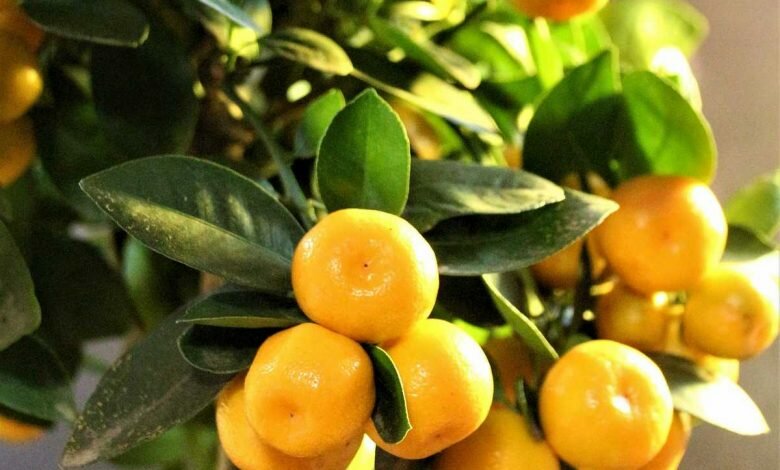
The calamondin is a citrus fruit more decorative than edible, appreciated for its small fragrant white flowers and its orange fruits present almost all year long. It is the only citrus fruit that can be enjoyed indoors.
What you need to know:
Botanical name: Citrus x mitis or Citrus madurensis
Common name: Calamondin, apartment orange, indoor orange
Family: Rutaceae
Height x spread : 1,50 m in pot, the shrub can reach 3 m height for 2 m wide when cultivated in ground
Foliage: evergreen, dense, shiny, carried by fine branches. The calamondin develops a compact port.
Fruits: The numerous round and green fruits, like small mandarins, persist almost all year long on the tree. They turn orange when ripe, in winter, but have a bitter taste.
Flowers : From March to June, the bloom is decorative. Small, white, starry, very fragrant flowers appear at the end of the branch.
Exposure: Half-shade in summer, sunny the rest of the year, especially in winter, always sheltered from the wind.
Soil: Any rich, non-calcareous soil is suitable, ideally slightly acidic. In pot: a mixture of garden soil, potting soil and sand.
Hardiness: – 5°C to -6°C. A winter temperature between 5 and 12°C suits it well.
Cultivation of the calamondin: inside or outside
The calamondin is the only citrus fruit which supports the dry atmosphere of a culture in inside, from where its nickname of orange tree of apartment. Nevertheless, it is necessary that the temperatures remain relatively fresh (18°C). This is the reason why it prefers in winter the freshness and the luminosity of an unheated veranda: the tree is then more beautiful.
In regions with a mild climate (South of France, Mediterranean coast, some places on the Atlantic coast up to Brittany), it also likes to grow outdoors, in the open ground, sheltered from cold winds.
Cultivation in pots of the calamondin
Like all citrus fruits, the calamondin likes to be grown in pots, with a tendency to form a dwarf tree. Here are some tips for growing it in these conditions:
- When planting, choose a pot that is only slightly larger than your calamondin’s original container. You will increase its diameter with successive repottings, every 2 to 3 years approximately. This way you will obtain a calamondin with a balanced volume of roots and foliage.
- At adulthood, the tree is stabilized in a 40 cm diameter pot. Beyond that, it becomes too heavy to move.
- For planting as well as for repotting, use a well-drained and rich growing medium: about 1/3 garden soil, 1/3 citrus potting soil and 1/3 sand. At planting and for maintenance each year, spread a handful of compost on the surface.
Grow your calamondin orange tree outside from May to October, on the terrace, balcony or in the garden, placing it in partial shade. Bring it indoors for the winter or, ideally, in an unheated veranda.

Watering the calamondin
- In winter, if the tree is kept in a veranda, let the substrate dry well between two waterings. Indoors, watering should be done more frequently, but in smaller quantities. In any case, be careful not to leave water in the saucer to avoid root rot.
Spray the leaves regularly with warm non-calcareous water if temperatures are above 12°C. - During the summer, the house orange appreciates more generous watering, even daily. Water in the evening or early morning when it is very dry.
Fertilizing and fertilizing the calamondin
In March, topdress with ripe compost. Complete with citrus fertilizer once a month. Rather than a liquid fertilizer that tends to leach, use a powder or crystal form that you spread on the surface of the pot around the trunk, after a light watering.
Scratch lightly and then moisten the root ball again.
The indoor orange tree needs fertilization almost all year round, only stopped from mid-December to mid-February if the citrus is sheltered in a veranda. When grown indoors, it continues to grow in winter, so fertilization can continue, but at half the dose.
Pruning the calamondin
Rather than making sharp cuts at the end of winter, it is advisable to prune the thin branches that elongate very regularly.
These pinches help to maintain a compact and rounded silhouette. The only requirement is to disinfect the blade of the pruning shears in alcohol each time to avoid transmission of diseases or parasites between citrus trees.
Finally, watch out for mealy bugs and red spiders, which are common on calamondin as on all citrus fruits. Treat with a white oil insecticide if necessary.
Recommended varieties of calamondin
The green calamondin is the most classic. If you want more originality, choose a variegated calamondin:
- Citrus madurensis variegata: its leaves are variegated with three colors: green, yellow and a little white. This calamondin orange is more chilly than the green one and grows less quickly. The fruits are like the leaves: green, nicely streaked with light yellow. They become orange when mature.
- Other calamondins are variegated, cream for Albovariegata, almost more cream than green for aureovariegata. All are very decorative.
Did you know that?
Born from the marriage between a kumquat and a mandarin tree, the calamondin has characteristics of one or the other of these two citrus fruits: in its port, its foliage and its fruits!
The “oranges” of the calamondin are very bitter. This does not discourage some gourmands from making jam, marmalade or using them in confectionery! There is no need to peel them, their skin is very thin. They are eaten like kumquats.
The calamondin multiplies easily by marcotting its stems.

